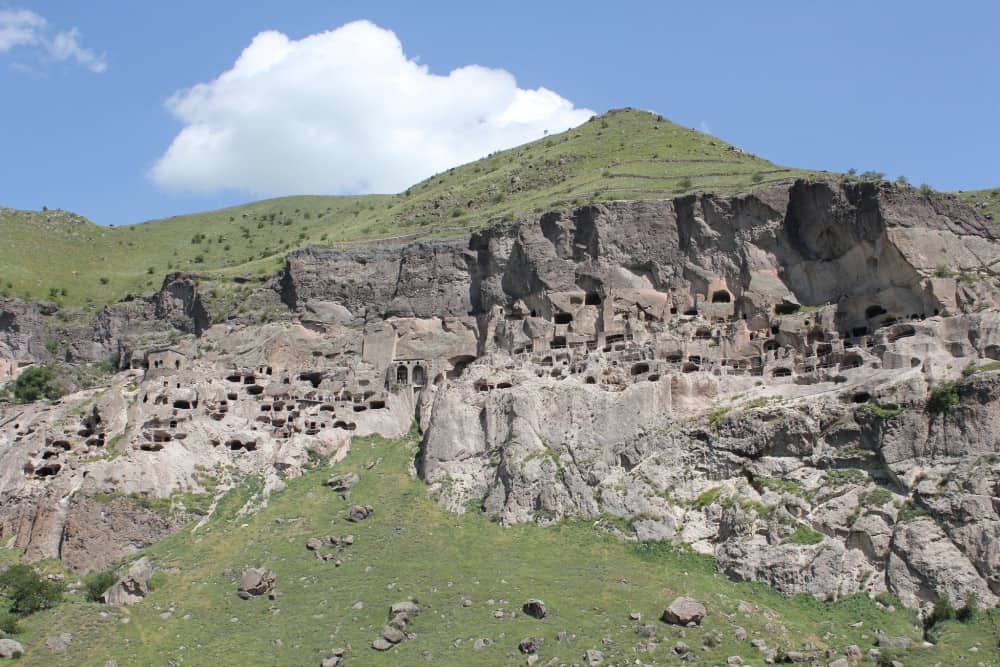Georgia sure is an interesting country for cavers. At the intersection of Asia and Europa, it has both Black Sea beaches and Caucasus caves. The impressive Caucasus mountains, with peaks of about 5kms high, offer a wide variety of trails, caves, and views. Due to its volcanic origin, the region can suffer from strong earthquakes.
Georgia is home four of the deepest known caves on Earth. If you plan on traveling to Georgia, be sure to visit the northwestern Caucasus; the Arabika massif is home to hundreds of caves and harbors the three deepest caves on Earth.
In this article, I’ll list the most important (known) cave structures in Georgia, and highlight a few to visit if you’re around. I’ve also created a map for you to get a feel for the locations of the caves.
List of Caves in Georgia
- Abrskil Cave
- Krubera Cave (second deepest cave in the world) (also Sibirskaya)
- New Athos Cave (showcave)
- Tekenteri cave
- Prometheus Cave Natural Monument (showcave)
- Satsurblia Cave
- Uplistsikhe cave (cave town)
- Vanis Kvabebi
- Vardzia
- Veryovkina Cave (deepest cave in the world)
- Sarma cave (third deepest cave in the world)
- Snezhnaja-Mezhonogo-Iljuzia System (fourth deepest cave in the world)
- Sataplia cave
- Pantjukhina cave
This list is by no means extensive: there are a lot of more caves to discover in Georgia (and there are discovered new caves all the time). But it gives you a good impression of some of the coolest, deepest, largest caves known to us to date.
If you’re in Georgia and interested in caves, you definitely want to visit at least the Prometheus show cave, which is one of the largest and most beautiful show caves in the world. The New Athos cave is also worth visiting.
If you want to know what to wear to one of these guided cave tours, make sure to read my article ‘What to Wear on a Cave Tour’ – which will explain precisely what types of clothes to wear – and what to avoid.
Let’s Put Them on a Map
To visualize the location of the caves I’ve put most of the listed caves above on Google Maps. May come in handy.
Prometheus Cave (showcave)

With 2,000 m in length this is the largest cave in Georgia, and one of the main tourist attractions in Georgia. Which means you aren’t allowed to enter on your own, as it’s not a wild cave. So if you’re up for a lazy afternoon you can join the guided tour, which runs for about an hour, kick back, and enjoy the spectacle. With about 70,000 visitors each year, expect large groups (40 people) and a good light show. Entrance fee is around $25.
New Athos Cave (showcave)
The New Athos Cave is one of the largest caves in the world and a large tourist attraction. It’s well lit and very popular, so you should get your tickets ahead of time. The entire 1,900 m length is opened to the public. Also known as Novoafonskaya, this cave has its own metro, and at about $7, the entrance fee is reasonable in my opinion.
Uplistsikhe cave (cave town)

Uplistsikhe is an ancient rock town, dating back to the Bronze Age. The town is filled with pagan temples, as it knew its heyday before the introduction of Christianity. Its one of the oldest settlements in Georgia, and at one point in time has had around 20,000 inhabitants. Uplistsikhe literally means ‘the lord’s fortress’.
It’s also on the tentative list for inclusion on UNESCO World Heritage. Although not a site to go hardcore caving, a very special site and perhaps worth the trouble to go check out.
Vardzia (cave monastery)

Vardzia is a monastery which was built in the second half of the 12th century. The monastery is 500 m long, and home to five monks, who still live in the Erusheti Mountain. It’s also on the tentative list for UNESCO World Heritage.
About the Krubera Cave

The Krubera Cave is a large wild cave. It was the deepest known cave for more than a decade, until, in August 2017, the Perovo-speleo team explored the Veryovkina Cave beyond the 2,204m point, at which the Veryovkina became the deepest cave on Earth. These two caves are the only two known caves deeper than 2km’s.
Who discovered Krubera cave?
In 1909, Alexander Kruber started to study the Krubera cave. Later on, the cave was renamed after him. Back then, the cave was thought to be just a couple of hundred meters. It wasn’t up until the 1960’s that the true potential of this cave was discovered. In 1987 the cave was explored by Alexander Klimchouk to a depth of about 340 meters. In 2010 the cave was explored to a depth of 1,710 meters. In 2012 the exploration passed the 2km mark.
Krubera Cave expedition documentary
The Ukrainian Speleological Association, who led several expeditions of the Krubera Cave (and was responsible for the > 2km expedition) made the following video about the expeditions.
About the Arabika massif
The Arabika massif is situated in the Gagra Range, south of the Greater Caucasus mountains (Abhkazia, Georgia). It’s a 13-km long limestone massif with immense differences in height. It’s peaks reach up to about 2,600m (Its highest peak is called Peak of Speleologists, at 2,705m) and it contains deeply incised canyons, which sink below sea level constantly. The area is heavily forested, making for some beautiful scenery.
Experts suspect the possibility of ‘amazingly deep caves’ – which of course already shows in the race for the deepest cave on Earth. This northwestern part of the Caucasus contains the three deepest caves in the world. And the fourth is right around the corner, in the Khipstinsky karstic massif.
If you want to know more about the deepest caves on earth, you could read my previous article on the 5 deepest caves on Earth.
Location and Depth of Wild Caves
Visiting one of the showcaves shouldn’t be a problem, but visiting one of the wild caves could be a lot more difficult. I’ve researched and found the GPS coordinates of the deepest caves of the world, in case you might need them. (I’m afraid I wasn’t able to find the coordinates of the Snezhnaya cave. I hope to update it later.)
| Cave | depth (m) | location (GPS) |
|---|---|---|
| Veryovkina | 2212 | 43° 24′ 56″ N, 40° 21′ 23″ E |
| Krubera / Voronya / Sibirskaya | 2197 | 43° 24 ′35″ N, 40° 21′ 44″ E |
| Sarma | 1830 | 43°24′0″N 40°21′0″E |
| Snezhnaya | 1760 |
Related Questions
What’s the temperature inside caves? The temperature inside caves generally ranges from 40 – 60 °F (or 5 – 15 °C). Cave temperatures are very stable; it remains the same throughout the year. The temperature of caves in colder climates is usually on the lower end, around 40 °F (or 5 °C). In warm climates, cave temperatures are still cool but will average around 60 °F (or 15 °C).

